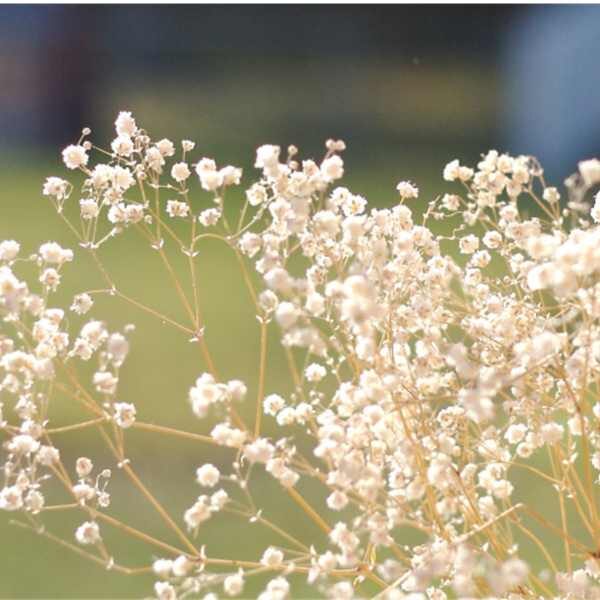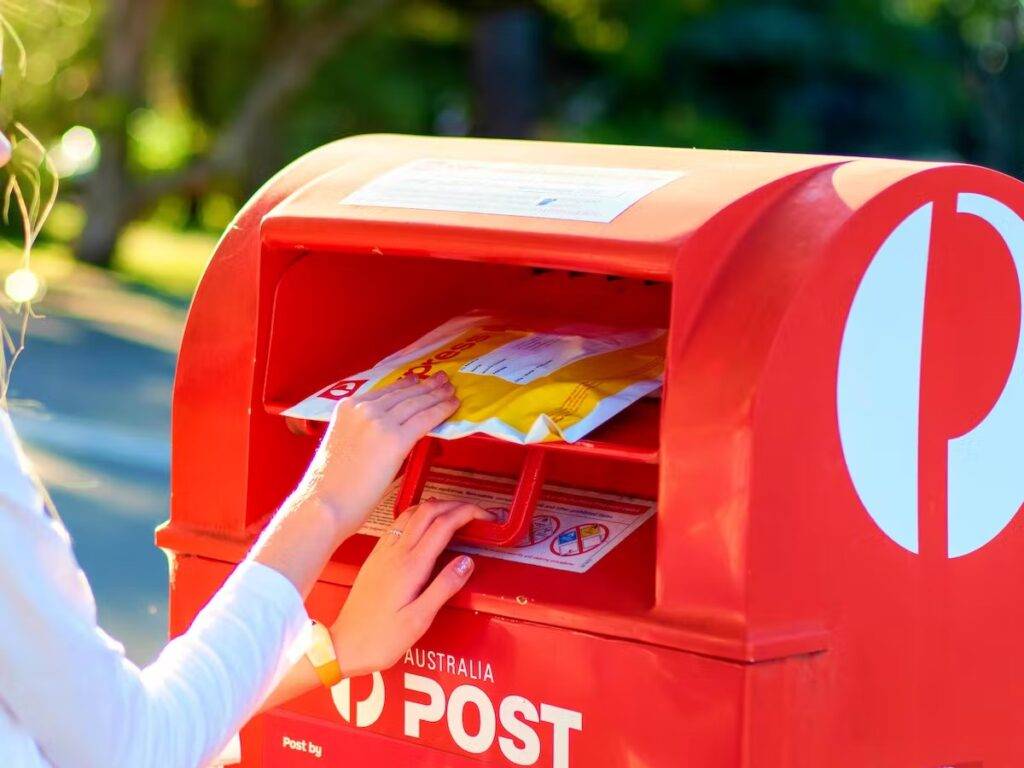Gypsophila Snowflake
$4.95
Gypsophilia Paniculata
- Seed Count 350
- Gorgeous Cut Flower
- Perennial
- Height 90 cm
In stock
Description
Gypsophila Snowflake, better known to many as Baby’s Breath, is a visual multitasker. In the garden, it forms decorative mounds of feathery blue-green foliage, reaching up to 90cm in height and spreading 60cm wide. But it’s the flowers that steal the show. From late spring through summer, the plant becomes dotted with countless tiny, pure white blooms that linger, creating a long-lasting display that seems to hover above the foliage like a delicate veil.
Pair it with bold, vivid blooms such as roses or dahlias and watch how it softens their intensity, and planted en masse, it transforms into a sea of white suiting cottage gardens, modern landscapes, and everything in between.
Once established, it’s remarkably resilient, tolerating both drought and poor soils and its compact, self-supporting habit means minimal fuss with no staking or constant pruning. It simply does its job, year after year, with a solid reliability.
And then there’s its secondary life as a cut flower. Gypsophila’s tiny blooms are the florists’ secret weapon, adding volume, texture, and a touch of romance to bouquets. The stems dry beautifully, too, retaining their shape and colour long after summer fades. For anyone who loves bringing the garden indoors, this plant is ideal.
| Method: Sow direct or seedlings | Soil Temp: 10°C - 25°C |
| Cool Mountain: Nov - Dec | Position: Full sun |
| Arid: Aug - Jan | Row Spacing: 25 cm apart |
| Temperate: Sep-Nov, Mar-Jun | Planting Depth: 3 mm |
| Sub Tropical: May - Oct | Harvest: 80 days |
| Tropical: Jun - Aug | Plant Height: 90cm |
Basics
- Capsicum (sweet/bell Capsicum) thrives in warm, sunny gardens.
- Plant them in a spot with full sun (6+ hours) and rich, well-drained soil.
- Prepare the bed by removing weeds and digging in plenty of compost or aged manure.
- Use mulch around plants to retain moisture and suppress weeds.
Seed Trays vs Direct Sowing
Seedling Trays:
- Raise seeds in pots or trays filled with seedling mix, keeping them warm (16-35°C) and moist.
- This protected start speeds germination and gives plants a head start on weeds and weather.
- You’ll use fewer seeds and get sturdy seedlings for an earlier crop.
- The downside is extra effort and cost (pots, mix, heat source) and you must harden-off seedlings before planting out.
Direct Sowing:
- Plant seeds 3mm deep in the garden soil 50cm between plants, 60–100cm once it’s warm and frost-free.
- Direct sowing is simpler and cheaper (no trays or special mix), but germination is slower and more vulnerable to cold, pests or heavy rain.
- Capsicum seeds can take 1–3 weeks to sprout at 16–35°C.
- Ensure the soil stays evenly moist (not waterlogged) during this time.
In short: use trays if you want the best germination and an early start; sow direct if you prefer simplicity and have already warm conditions.
Planting and General Care
Timing & Spacing:
- Plant or transplant capsicum after all danger of frost has passed.
- In tropical/subtropical areas, Capsicums can even fruit year-round, but in cooler zones treat them as an annual summer crop.
Soil:
- Use well-drained, fertile soil rich in organic matter.
- Work in compost or aged manure before planting.
- Capsicums prefer a slightly acidic to neutral pH (~6.0–7.0).
- In pots, use at least ~40L per plant.
Watering:
- Water deeply and regularly, so the soil stays evenly moist.
- Check soil moisture by pushing a finger 4–5cm down; water when that layer is just dry.
- Water in the early morning or late afternoon to minimize stress.
- Avoid wetting the leaves, which can encourage fungal disease.
- Mulch around plants to keep roots cool and reduce evaporation.
Fertilising:
- If the soil was well-prepared, you may need little extra feed.
- Otherwise, apply a balanced (e.g. 10-10-10 NPK) slow-release fertilizer at planting.
- Once flowers and fruit start, give a liquid tomato or vegetable fertilizer every few weeks according to label directions.
- This supports heavy fruiting. Avoid excessive nitrogen late in the season, as it can reduce fruit set.
Staking & Pruning:
- Capsicum plants can get top-heavy with fruit. Stake or cage them when planting.
- A simple sturdy stake beside each plant works – gently tie the main stem (e.g. with soft string) as it grows.
- This prevents wind damage and keeps fruit off the ground.
- Remove any low or damaged leaves to improve air flow.
- Many gardeners also pinch out a few early flower buds when plants are young – this encourages stronger vegetative growth and heavier later yields.
- Overall, little pruning is needed beyond this.
Pest & Disease Management:
- Monitor plants for pests like aphids, caterpillars, slugs/snails, and chilli thrip.
- Hand-pick pests or use organic sprays if needed.
- Practice good hygiene: remove weeds and crop debris.
- Rotate capsicum/solanaceous crops to a different spot each year to reduce disease pressure.
- Common diseases include blossom-end rot (from inconsistent watering or low calcium) and fungal spots.
- Regular watering and mulch help prevent blossom-end rot.
- Crop rotation and not overcrowding plants also reduce problems.
Chilli Thrips: What They Are & How to Deal With Them
- Chilli thrips (Scirtothrips dorsalis) are tiny, slender insects that can cause big problems in home veggie patches—especially for capsicum, chilli, eggplant, and tomato plants.
- You might not see them easily (they’re less than 2mm long!), but the damage is easy to spot as leaves curl or look bronzed and scarred, buds drop off, and fruit can become deformed or scarred.
- These pests feed by piercing plant tissue and sucking out the juices, which leads to silvery or brown patches on leaves and distorted growth.
- They tend to hang out on the newest growth, flower buds, or the undersides of leaves—so grab a magnifying glass and check these spots first if your plants are looking stressed.
What You Can Do:
Prevention is key:
- Start clean – Avoid bringing in infested seedlings or cuttings.
- Attract beneficial bugs like lady beetles, lacewings, and predatory mites—they’ll help keep thrip numbers down.
- Plant flowers like alyssum, marigold, or dill nearby to draw in the good guys.
If they show up:
- Prune affected areas early to stop the spread.
- Hose them off gently with water to dislodge thrips from foliage.
- Apply insecticidal soap or horticultural oil, covering all leaf surfaces, especially underneath. Repeat weekly as needed.
- Rotate your crops each year to disrupt their lifecycle.
Tip: Thrips love hot, dry conditions—so keep your plants well-watered and mulched to reduce stress and deter infestations.
Companion Planting with Capsicum
Good companions:
- Herbs & Flowers: Basil, dill, parsley, coriander, chamomile and other aromatic herbs as they attract beneficial insects and may repel aphids or whiteflies. Garlic, onions, chives as their strong scent deters many pests. Marigolds, nasturtiums, borage, lavender as these flowers lure pollinators and trap pests (marigolds are famous for nematode control).
- Vegetables: Carrots, lettuce, spinach as they occupy shallow roots and don’t compete much with Capsicums. These can provide light ground cover under Capsicum plants. Tomatoes are sometimes planted alongside Capsicums (both like similar conditions) but be aware they share some pests/diseases so give them space and rotate beds regularly.
- Fruits: Strawberries and cucumbers have been noted as decent neighbours (shallow roots and shade from cucumber leaves can protect Capsicums).
Bad Companions
- Other heavy feeders or close relatives.
- Do not grow next to eggplants, potatoes or tomatoes in succession, as they share pests/diseases.
- Stay away from beans/peas and plants like fennel or dill, which can inhibit Capsicum growth.
- Squash and pumpkins (deep-rooted cucurbits) can out-compete Capsicums for nutrients.
- In short, pair Capsicums with light-feeders and pest-deterring plants, and keep them apart from other nightshades and big gourds.
Seed Saving
Saving your own Capsicum seeds is easy if you follow a few simple steps:
Select plants:
- Pick the healthiest plants with strong, typical fruit.
- If growing multiple types, isolate them (e.g. bag flowers or keep 20m+ apart) to prevent cross-pollination.
Harvest ripe fruits:
- Wait until Capsicums are fully ripe on the plant which is usually when they’ve changed to their final colour and just start to soften or wrinkle.
- Allowing fruits to over ripen a little ensures the seeds are mature.
Extract seeds:
- Cut the Capsicum in half and scoop or twist out the central core.
- Scrape out the seeds and remove as much of the inner flesh and pith as possible.
- Rinse the seeds in clean water to wash off any remaining pulp which helps them dry cleanly.
Dry seeds:
- Spread the seeds in a single layer on paper towels or a clean plate in a dry, shaded place.
- Let them dry completely over several days.
- They’re ready when you can crunch a seed in your fingers and it snaps rather than bends.
- Moisture is the enemy of seed storage, so make sure they feel fully dry.
Store seeds:
- Transfer the dried seeds to a paper envelope or small jar with a tight lid.
- Label with variety and date.
- Store in a cool, dark, dry spot (a refrigerator works well).
- Properly stored Capsicum seeds remain viable for about 3–4 years, so you’ll have plants for many seasons.
Climate & Timing
Sowing Time:
- In frost prone areas, sow seeds in spring after the last frost (September–November).
- In frost free regions, autumn sowing (March–May) is also suitable for extended blooms.
Avoid extreme heat or cold, as these conditions hinder germination.
Soil Preparation
Soil Type:
- Gypsophila thrives in well drained, sandy, or gritty soil with a slightly alkaline pH (6.5–7.5).
- Avoid heavy clay soils.
Amendments:
- If soil is acidic, add garden lime to raise ph.
- Gypsophila prefers poor to moderately fertile soil so avoid over enriching with compost or manure.
Sowing Instructions
Direct Sowing:
- Scatter seeds 3 mm deep, spacing 25 cm apart, crowding promotes better blooms.
Germination:
- Seeds sprout in 7–14 days at 10 – 22°C.
- Keep soil moist but not waterlogged.
Containers:
- Use pots greater than 10L with quality potting mix.
- Ensure drainage holes to prevent root rot.
Care Tips
Watering:
- Water deeply but infrequently—allow soil to dry 10cm below the surface between watering.
- Avoid wetting foliage to prevent fungal issues.
Feeding:
- Avoid high nitrogen fertilisers.
- Apply a high potassium liquid feed (e.g., tomato fertiliser) during flowering for a boost.
Support:
- Tall varieties may need stakes or trellises.
- Install supports early to avoid root disturbance.
Harvesting
Cut Flowers:
- Harvest stems when half the flowers are open, ideally in the morning.
- Place in water immediately.
Drying:
- Cut stems when 50% of blooms are open.
- Hang upside down in a dark, ventilated area until papery.
Troubleshooting
Pests:
- Aphids, spider mites, and thrips can be managed with insecticidal soap or eco oil.
Diseases:
- Root rot from overwatering—ensure soil drainage.
- Gray mould (Botrytis) is treated by removing affected parts and improving airflow.
Companion Planting Guide
Best Companions
- Lavender: Repels pests (e.g., aphids) and shares Gypsophila’s love for full sun and dry soil.
- Marigolds: Deter nematodes and add vibrant colour contrast.
- Echinacea (Coneflower): Attracts pollinators and thrives in similar drought tolerant conditions.
- Salvia: Tall, upright growth complements Gypsophila’s airy texture.
- Coreopsis: Offers long lasting blooms and harmonizes with Gypsophila’s care needs.
Plants to Avoid
- Peonies: Compete aggressively for nutrients.
- Cabbage Family: Attracts pests like cabbage worms.
- Fennel: Releases growth inhibiting chemicals.
Seed Saving Guide
Harvesting Seeds
Timing:
- Let flowers fully mature and dry on the plant.
- Seeds are ready when pods turn brown and rattle.
Method:
- Place a paper bag over seed heads before cutting stems to catch fine seeds.
- Shake gently to separate seeds from debris.
Storage Tips
Viability:
- Gypsophila seeds remain viable for 2–4 years if stored properly.
Conditions:
- Store in an airtight container (e.g., glass jar) with a desiccant.
- Keep in a cool, dry place.
Postage Charge
Orders under $30 attract a $4.95 shipping charge. Orders $30 and above have free shipping.
Order Times
Seed orders are normally dispatched within three business days. You will receive an email when seeds are mailed out.
Postage Days
Seeds are mailed out Monday to Friday at 1pm. Except for the Friday of long weekends.
Postage Times
WA 2-3 Days: SA,NT 3-5 Days: NSW, ACT, QLD, VIC: 5-7 Days
Carrier
We use Australia Post Letter Postage for the majority of orders
Not only are our seeds packed in recycled paper envelopes, we keep the theme going when we post out website orders. To protect your seeds from moisture and the letter box munchers (snails), we use a very special plastic free material made from plants. They are then put into recycled mailing envelopes. Green all the way 💚🌿

















Well packaged. Can’t wait to plant them.